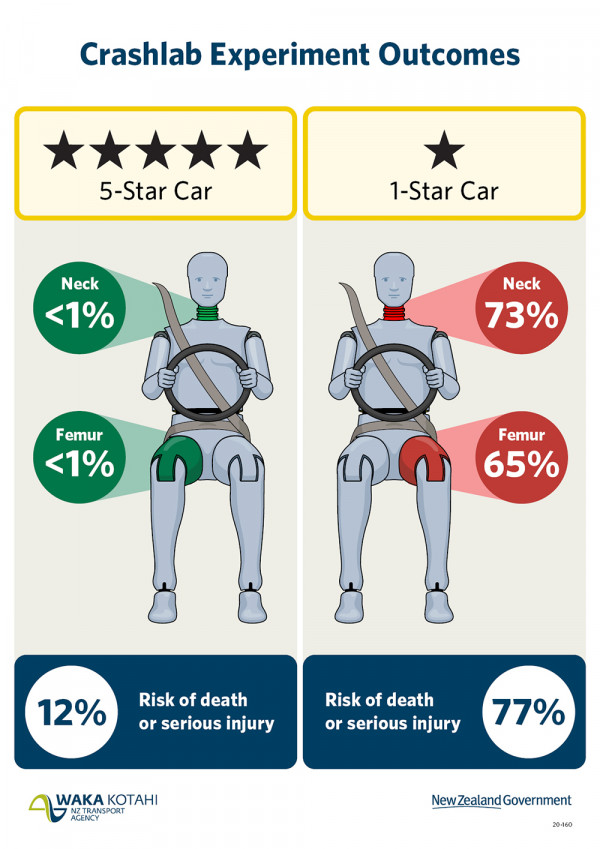Compelling new crash test footage released today by Waka Kotahi NZ Transport Agency provides graphic evidence that the choice you make when buying your next used car could be a life and death decision.
New crash test footage(external link)
The footage shows the results of a controlled offset frontal crash test carried out at a speed of 64km/h between two used vehicles - a 2010 model with a 1-star safety rating vehicle, and a 2008 model with a 5-star safety rating.
The two models used in the crash were chosen in consultation with the Automobile Association (AA), as similar cars are widely available as used vehicles in New Zealand, within a similar modest price range.
The crash test was carried out earlier this year in the Transport for New South Wales Crashlab facility, as part of Waka Kotahi’s Safe Vehicles Programme, which aims to get more Kiwis into cars with 4 or 5-star safety ratings. The 64km/h head-on crash test simulates a common high-speed crash scenario, where one vehicle drifts over the centre line on an open road.
Crashlab facility(external link)
The contrast in the outcome of the crash for occupants of the two vehicles is stark, with readings taken from the instrumented crash test dummies in each car showing a 77% chance of serious injury for the driver of the 1-star rated vehicle compared to just a 12% chance of serious injury for the driver of the 5-star car.
Waka Kotahi NZ Senior Road Safety Manager Fabian Marsh says the crash test result provides further evidence of the value of star ratings.
“Checking the safety rating before buying your next car could well save your life. Research shows that vehicle occupants are twice as likely to die or be seriously injured in a crash in a one or two-star rated car than they are in a five-star rated vehicle, and this latest crash test result backs that up.
“The numbers are clear, the higher the safety rating the more likely you are to avoid serious injury or death in a crash.” Mr Marsh says.
AA Principal Advisor Regulations Mark Stockdale says the results of the test demonstrate why everyone should buy the safest vehicle they can afford.
“The two models used in the crash are similar in size. Variants of these models are widely available as used vehicles in New Zealand, within a similar price range, but there is a huge difference in the level of protection they provide in a crash,” Mr Stockdale says.
Monash University Accident Research Centre Associate Director Stuart Newstead reviewed the crash test result for Waka Kotahi, and agrees the results are compelling.
“The results are very clear - the occupant cell of the 1-star collapses, crushing the driver's legs. In the real world this is very likely to lead to a serious injury or death, particularly if the major arteries in the legs were compromised.
“The driver of the 1-star car in this crash would also have suffered a serious neck injury due the level of structural damage. The 5-star car hasn’t had the same level of structural damage. This shows that structural integrity is a key aspect of vehicle safety. It’s not enough to say a vehicle has an airbag so it will be safe. A car is designed as a wholistic system of interacting parts and they all need to work together properly to make sure the occupants are protected.”

The graphic shows crash test results for a 5-star rated vehicle compared with a 1-star rated vehicle.
Safety ratings indicate the likely performance of your vehicle in a crash, from 1 to 5 stars. Vehicles with 4 and 5-star ratings are the safest. The New Zealand light vehicle fleet currently has a high proportion of 1 and 2-star safety-rated vehicles (41 percent) that provide far less protection to occupants than higher-rated vehicles in the event of a crash.
A national advertising campaign launched in February as part of the Safer Vehicles programme targets people who are in the market to buy a new or used car, encouraging them to make safety a top factor in any vehicle purchasing decision. The campaign directs people to the newly designed and expanded Rightcar website, which now provides safety ratings covering around 95% of vehicles on New Zealand roads.
Mr Marsh says with approximately 800,000 vehicles changing hands in New Zealand each year there is great potential to save lives and prevent serious injuries by encouraging people to buy cars with a good safety rating. A new search filter launched by Trade Me earlier this month, supported by Waka Kotahi, also allows prospective buyers to search for vehicles by their safety rating.
“We all make mistakes when driving, and some crashes are inevitable, but safer vehicles can save lives in crashes. Checking a vehicle’s safety rating before you buy isn’t often high on the list of priorities for many New Zealanders, and we need to see that change.”
The Safe Vehicles programme delivers on the Government’s Road to Zero strategy which was released in December 2019. Road to Zero outlines a strategy to guide improvements in road safety in New Zealand over the next 10 years. It sets out a vision of a New Zealand where no one is killed or seriously injured in a road crash, with a key focus area of significantly improving the safety of New Zealand’s vehicle fleet.
Plan ahead for a safe, enjoyable journey. Keep up to date with: